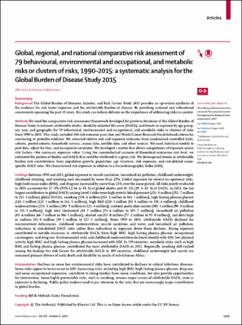Global, regional, and national comparative risk assessment of 79 behavioural, environmental and occupational, and metabolic risks or clusters of risks, 1990–2015: a systematic analysis for the Global Burden of Disease Study 2015
Date
2016-10-08Author
Forouzanfar, Mohammad H
Afshin, Ashkan
Alexander, Lily T
Bhutta, Zulfiqar A
Biryukov, Stan
Brauer, Michael
Burnett, Richard
Cercy, Kelly
Charlson, Fiona J
Cohen, Aaron J
Dandona, Lalit
Estep, Kara
Ferrari, Alize J
Frostad, Joseph J
Fullman, Nancy
Gething, Peter W
Godwin, William W
Griswold, Max
Hay, Simon I
Kinfu, Yohannes
Kyu, Hmwe H
Larson, Heidi J
Liang, Xiaofeng
Lim, Stephen S
Liu, Patrick Y
Lopez, Alan D
Lozano, Rafael
Marczak, Laurie
Mensah, George A
Mokdad, Ali H
Moradi-Lakeh, Maziar
Naghavi, Mohsen
Neal, Bruce
Reitsma, Marissa B
Roth, Gregory A
Salomon, Joshua A
Sur, Patrick J
Vos, Theo
Wagner, Joseph A
Wang, Haidong
Zhao, Yi
Zhou, Maigeng
Aasvang, Gunn Marit
Abajobir, Amanuel Alemu
Abate, Kalkidan Hassen
Abbafati, Cristiana
Abbas, Kaja M
Abd-Allah, Foad
Abdulle, Abdishakur M
Abera, Semaw Ferede
Abraham, Biju
Abu-Raddad, Laith J
Abyu, Gebre Yitayih
Adebiyi, Akindele Olupelumi
Adedeji, Isaac Akinkunmi
Ademi, Zanfina
Adou, Arsène Kouablan
Adsuar, José C
Agardh, Emilie Elisabet
Agarwal, Arnav
Agrawal, Anurag
Kiadaliri, Aliasghar Ahmad
Ajala, Oluremi N
Akinyemiju, Tomi F
Al-Aly, Ziyad
Alam, Khurshid
Alam, Noore KM
Aldhahri, Saleh Fahed
Aldridge, Robert William
Alemu, Zewdie Aderaw
Ali, Raghib
Alkerwi, Ala'a
Alla, François
Allebeck, Peter
Alsharif, Ubai
Altirkawi, Khalid A
Alvarez Martin, Elena
Alvis-Guzman, Nelson
Amare, Azmeraw T
Amberbir, Alemayehu
Amegah, Adeladza Kofi
Amini, Heresh
Ammar, Walid
Amrock, Stephen Marc
Andersen, Hjalte H
Anderson, Benjamin O
T Antonio, Carl Abelardo
Anwari, Palwasha
Ärnlöv, Johan
Artaman, Al
Asayesh, Hamid
Asghar, Rana Jawad
Assadi, Reza
Atique, Suleman
Arthur Avokpaho, Euripide Frinel G
Awasthi, Ashish
Ayala Quintanilla, Beatriz Paulina
Azzopardi, Peter
Bacha, Umar
Badawi, Alaa
Bahit, Maria C
Balakrishnan, Kalpana
Barac, Aleksandra
Barber, Ryan M
Barker-Collo, Suzanne L
Bärnighausen, Till
Barquera, Simon
Barregard, Lars
Barrero, Lope H
Basu, Sanjay
Batis, Carolina
Bazargan-Hejazi, Shahrzad
Beardsley, Justin
Bedi, Neeraj
Beghi, Ettore
Bell, Brent
Bell, Michelle L
Bello, Aminu K
Bennett, Derrick A
Bensenor, Isabela M
Berhane, Adugnaw
Bernabé, Eduardo
Betsu, Balem Demtsu
Beyene, Addisu Shunu
Bhala, Neeraj
Bhansali, Anil
Bhatt, Samir
Biadgilign, Sibhatu
Bikbov, Boris
Bisanzio, Donal
Bjertness, Espen
Blore, Jed D
Borschmann, Rohan
Boufous, Soufiane
Bourne, Rupert RA
Brainin, Michael
Brazinova, Alexandra
Breitborde, Nicholas JK
Brenner, Hermann
Broday, David M
Brugha, Traolach S
Brunekreef, Bert
Butt, Zahid A
Cahill, Leah
Calabria, Bianca
Campos-Nonato, Ismael Ricardo
Cárdenas, Rosario
Carpenter, David O
Carrero, Juan Jesus
Metadata
Show full item recordAbstract
Background The Global Burden of Diseases, Injuries, and Risk Factors Study 2015 provides an up-to-date synthesis of the evidence for risk factor exposure and the attributable burden of disease. By providing national and subnational assessments spanning the past 25 years, this study can inform debates on the importance of addressing risks in context. Methods We used the comparative risk assessment framework developed for previous iterations of the Global Burden of Disease Study to estimate attributable deaths, disability-adjusted life-years (DALYs), and trends in exposure by age group, sex, year, and geography for 79 behavioural, environmental and occupational, and metabolic risks or clusters of risks from 1990 to 2015. This study included 388 risk-outcome pairs that met World Cancer Research Fund-defi ned criteria for convincing or probable evidence. We extracted relative risk and exposure estimates from randomised controlled trials, cohorts, pooled cohorts, household surveys, census data, satellite data, and other sources. We used statistical models to pool data, adjust for bias, and incorporate covariates. We developed a metric that allows comparisons of exposure across risk factors—the summary exposure value. Using the counterfactual scenario of theoretical minimum risk level, we estimated the portion of deaths and DALYs that could be attributed to a given risk. We decomposed trends in attributable burden into contributions from population growth, population age structure, risk exposure, and risk-deleted cause-specifi c DALY rates. We characterised risk exposure in relation to a Socio-demographic Index (SDI).

